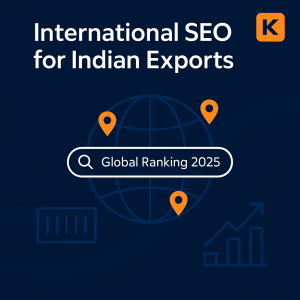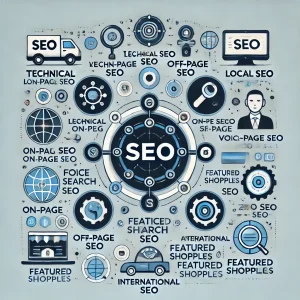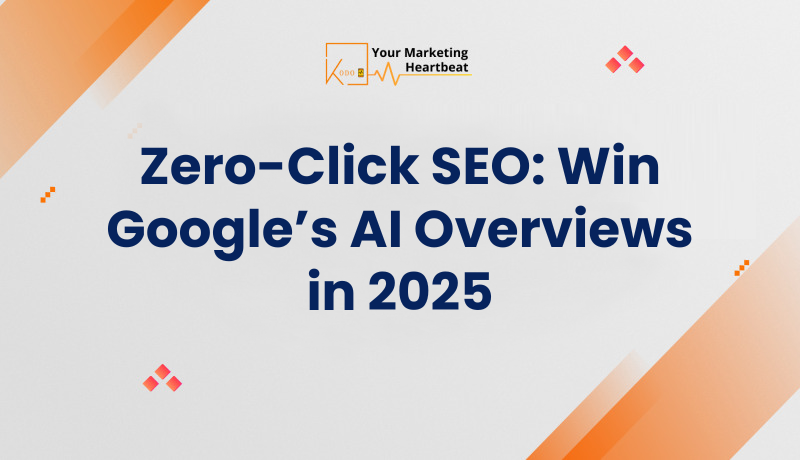
International SEO for Indian Exports: 2025 Global Ranking Strategies
In an increasingly interconnected world, the importance of international SEO cannot be overstated, especially for Indian exporters looking to expand their reach. As we approach 2025, businesses must adapt their digital strategies to tap into global markets effectively. This article will explore the essential components of international SEO, focusing on strategies that can elevate Indian exports on the global stage.
Understanding International SEO
International SEO refers to the process of optimizing your website to rank in search engines across different countries and languages. Unlike local SEO, which targets specific geographic areas, international SEO aims to reach a broader audience by catering to diverse markets.
Why is International SEO Important?
- Market Expansion: With the right strategies, businesses can access new customer bases, increasing sales and brand recognition.
- Competitive Advantage: Many companies are still not leveraging international SEO, providing a unique opportunity for early adopters.
- Cultural Relevance: Tailoring content to resonate with local audiences fosters trust and engagement.

Key Components of International SEO
To effectively implement international SEO, businesses must focus on several critical components:
1. Hreflang Implementation
Hreflang tags are essential for indicating to search engines which language and regional version of a webpage to display. This prevents issues with duplicate content and ensures users land on the most relevant page.
- Best Practices:
- Use hreflang tags for each language version of your pages.
- Ensure that each page has a self-referencing hreflang tag.
- Regularly audit your hreflang implementation to avoid errors.
2. Geo-Targeting
Geo-targeting involves customizing your website to cater to specific countries or regions. This can significantly enhance user experience and improve search rankings.
- Strategies:
- Utilize country-specific domains (ccTLDs) or subdirectories to organize content.
- Optimize content based on local search trends and preferences.
- Implement local backlinks to improve authority in targeted regions.
3. Cultural Content Adaptation
Cultural nuances play a vital role in international SEO. Adapting content to reflect local customs, language, and preferences can enhance engagement and conversion rates.
- Considerations:
- Research local idioms and expressions to ensure relevance.
- Adjust imagery and design elements to align with cultural expectations.
- Tailor marketing messages to resonate with local values and beliefs.
Conducting Market Research
Before diving into international SEO, it’s crucial to conduct thorough market research. Understanding your target audience’s needs and preferences will inform your strategy.
Steps for Effective Market Research
- Analyze Current Traffic: Use tools like Google Analytics to identify where your visitors are coming from.
- Identify Demand: Research potential markets to determine demand for your products or services.
- Competitor Analysis: Study competitors in your target markets to understand their strategies and performance.
Setting Clear Goals
Establishing clear, measurable goals is essential for any international SEO campaign. These goals will guide your strategy and help you assess performance.
Goal-Setting Framework
- SMART Goals: Ensure your goals are Specific, Measurable, Achievable, Relevant, and Time-bound.
- Examples:
- Increase organic traffic from targeted countries by 30% within six months.
- Achieve a top-three ranking for specific keywords in new markets.
Budgeting for International SEO
International SEO can be resource-intensive, so it’s vital to set a realistic budget. Consider the following expenses:
- Website Localization: Costs associated with translating and adapting content.
- Technical SEO: Hiring experts to implement hreflang tags and optimize site structure.
- Keyword Research Tools: Subscriptions to tools like Ahrefs or SEMrush for global keyword insights.
- Link Building: Investment in acquiring high-quality backlinks from local sources.
Building Your International SEO Team
A successful international SEO strategy requires a skilled team. Depending on your resources, you may choose to hire in-house experts or collaborate with agencies.
Team Composition
- SEO Specialists: Experts in international SEO practices and technical optimization.
- Content Creators: Writers familiar with local languages and cultural nuances.
- Project Managers: Individuals to oversee the campaign and ensure alignment with goals.
Creating a Comprehensive Roadmap
A well-structured roadmap will guide your international SEO efforts. This should outline your target markets, strategies, and timelines.
Key Elements of Your Roadmap
- Target Languages and Regions: Specify which languages and countries you will focus on.
- Technical Setup: Detail the necessary technical changes, including hreflang implementation.
- Content Strategy: Plan for localized content creation and adaptation.
- Link Building Strategy: Outline how you will acquire backlinks in each target market.
Tracking and Measuring Performance
Regularly monitoring your international SEO performance is crucial for success. Utilize various tools to track key metrics.
Metrics to Monitor
- Traffic Sources: Analyze where your traffic is coming from and which regions are performing best.
- Keyword Rankings: Keep track of your rankings for targeted keywords in different markets.
- Conversion Rates: Measure how well your international pages convert visitors into customers.
Common Mistakes to Avoid
As you embark on your international SEO journey, be aware of common pitfalls that can hinder your success.
Mistakes to Watch Out For
- Neglecting Local Keyword Research: Failing to adapt your keyword strategy for different markets can lead to poor performance.
- Ignoring Cultural Differences: Not considering local customs and preferences can alienate potential customers.
- Inadequate Hreflang Implementation: Errors in hreflang tags can confuse search engines and lead to missed opportunities.
Conclusion
As we look toward 2025, the potential for Indian exports in the global market is immense. By implementing effective international SEO strategies, businesses can enhance their online presence, reach new customers, and ultimately drive growth. Remember, the key to success lies in understanding your target markets, adapting your content, and continuously monitoring your performance. With the right approach, the world is your oyster.
This article provides a comprehensive overview of international SEO strategies tailored for Indian exporters, ensuring a unique and engaging read while adhering to the specified guidelines.







